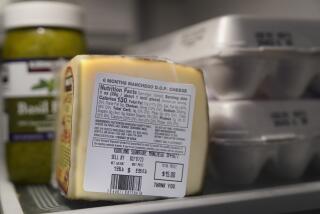Handle Holiday Goodies Carefully
- Share via
Mail-order foods is a big part of holiday giving. But the U.S. Department of Agriculture reports that those baskets of summer sausage, cheeses and jams can also cause health problems if the foods are not properly packaged and handled. E-commerce is causing a rise in the number of mail-order food stores, so here is a checklist of what to watch for when sending or receiving food via mail:
Ask the Company
Ask the mail-order company how the gift will be packaged. It should be packed in foam or heavy corrugated cardboard. If it’s a perishable product, it should be cold or frozen and packed with a cold source such as dry ice or frozen gel-packs.
Speedy Delivery
Ask the company how the food will be mailed. If it’s a perishable product, it should be delivered as quickly as possible--ideally, overnight. Make sure perishable products and the outer package are labeled “Keep Refrigerated” to alert the recipient.
Storage and Preparation Instructions
Will the product come with storage and preparation instructions? Some mail-order food gift items are of an unusual nature and consumers might not know how to handle or prepare them.
Arrange a Delivery Date
Tell the recipient if the company has promised a delivery date. Or alert the recipient that “the gift is in the mail” so they or a neighbor can be home to receive it. Otherwise, it may sit on the front porch or at the post office for hours, or even days.
Check the Temperature
When you receive a food product marked “Keep Refrigerated,” open it immediately and check the temperature. Optimally, the food should arrive frozen or partially frozen with ice crystals still visible, or at least, refrigerator-cold to the touch. If perishable food arrives warm, notify the company if you think you deserve a refund. Do not consume the food. It’s the shipper’s responsibility to deliver perishable foods on time and the customer’s responsibility to have someone at home to receive the package.
Keep It Cold
Refrigerate or freeze perishable foods immediately. Even if a product is partially defrosted it is safe to freeze it, although there may be a slight loss of quality.
Food Gifts: How to Store Them, How Long They’ll Last
* Cans or jars of meat--Refrigerate if so labeled, otherwise unopened products are shelf-stable for two to five years. After opening, store in the refrigerator up to a week.
* Cheese, processed or hard--Safe at room temperature, but refrigeration prolongs quality.
* “Cook-before-eating” ham--Refrigerate up to one week. After cooking, refrigerate for up to five days.
* Country ham--Shelf-stable for one year if unsliced. Refrigerate for two to three months if sliced. Once cooked, refrigerate for five to seven days.
* Game birds--Keep refrigerated for up to two days raw or four days after cooking.
* Sausage labeled “Keep Refrigerated”--Store refrigerated up to one week.
* Sausage, Hard/Dry--If unopened, it can be kept in the cupboard or pantry for four to six weeks or in the refrigerator six months. After opening, store for up to three weeks in the refrigerator.
* Frozen food--Stays safe indefinitely but may lose quality and flavor. Don’t freeze canned food. Expanding contents may burst seams causing leakage and rusting.
Holiday Potluck Tips
* Keep all perishables in a cooler with ice or freeze-packs until serving time.
* When taking a hot covered dish to a potluck, pack it in an insulated chest, then keep hot.
* Hot food that has been held at room temperature for more than two hours during serving is not safe and should be discarded.
More to Read
Eat your way across L.A.
Get our weekly Tasting Notes newsletter for reviews, news and more.
You may occasionally receive promotional content from the Los Angeles Times.









